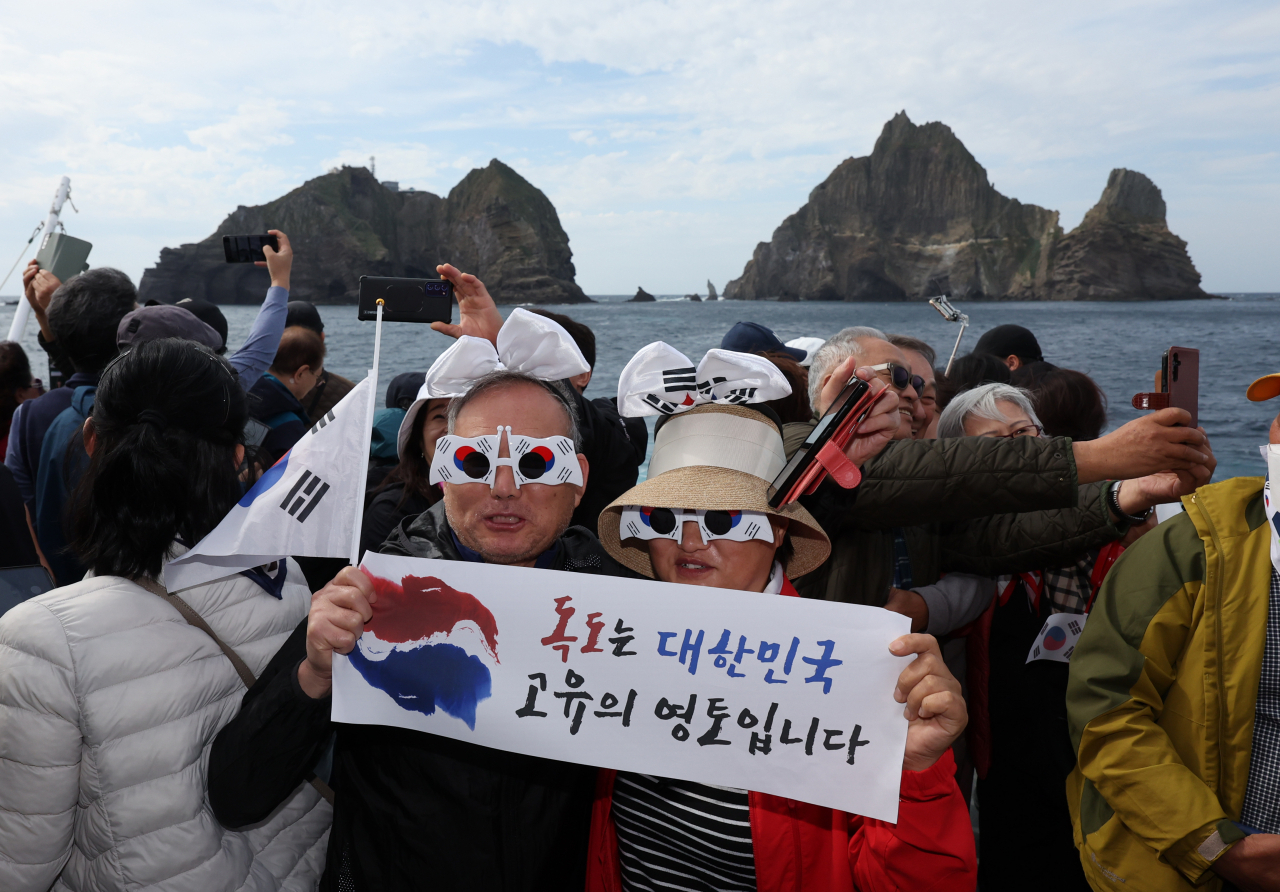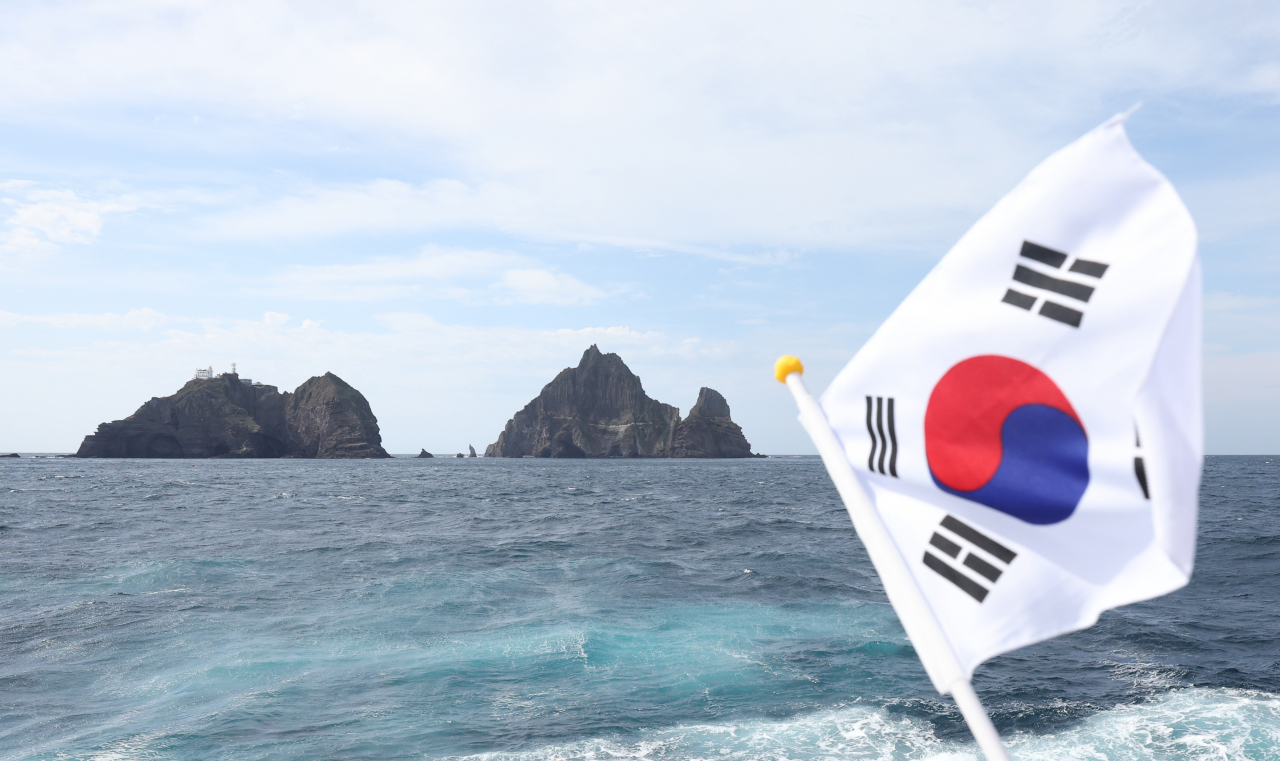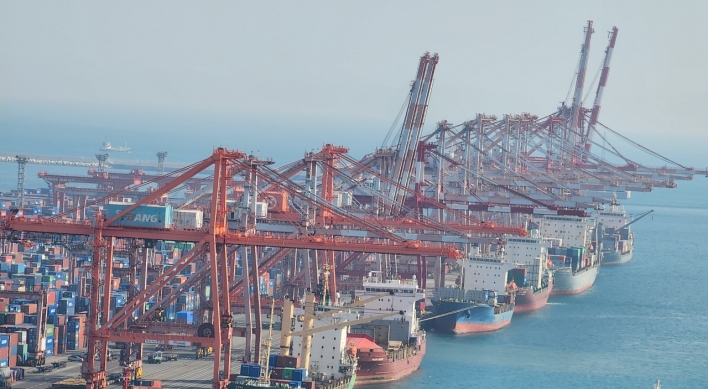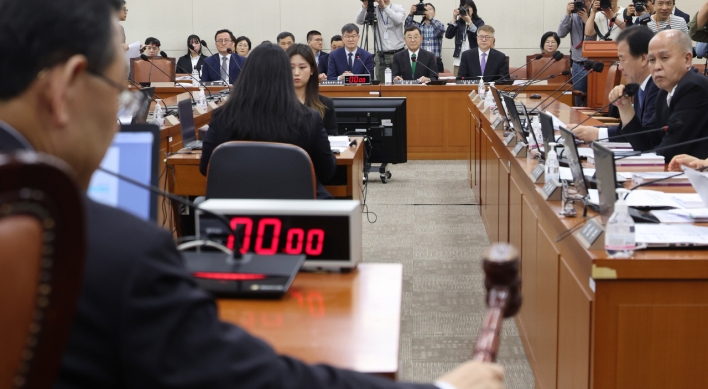Braving wind and high water to celebrate Dokdo Day
By Park Ga-youngPublished : Oct. 24, 2023 - 19:25

ULLEUNGDO, North Gyeongsang Province -- On Oct. 19, more than 100 eager individuals embarked on a journey, hoping to set their feet on the Dokdo islets, South Korea's easternmost outpost, just days before Dokdo Day on Oct. 25.
The sense of anticipation and yearning to reach the remote and symbolic islets was palpable. For many, this opportunity to visit Dokdo was a rare and cherished one, and the journey itself was a testament to their determination.
One of the groups on that boat, guided by the staff of the Northeast Asian History Foundation, had traveled 2 1/2 hours by high-speed train from Seoul to Pohang Station before arriving at Pohang Ferry Terminal to board the New Shidao Pearl cruise ship bound for Ulleungdo that departed at 11:30 p.m. After a seven-hour voyage aboard the 20,000-ton cruise ship, they had disembarked at Ulleungdo, where they transferred to a smaller boat that could dock at Dokdo. They sailed for another 80 minutes on the last leg of the trip to Dokdo, 87.4 kilometers from Ulleungdo.
The significance of the timing of the trip could not be overlooked. Entry to Dokdo is only permitted between March and October, a concession to the island's inhospitable winter conditions characterized by biting cold and ferocious winds.
On Oct. 19, the boat's attempt to reach Dokdo failed due to rough waters and wind despite the blue and clear sky. The captain's announcement that they would be circling the islets rather than disembarking was met with sighs of disappointment.
According to the Dokdo Management Office, during the seven-month window only about 60 days have ideal conditions for boats to reach the island. However, the success rate is rising with more accurate weather forecasts. Even if the weather allows, visitors are usually allowed to stay only half an hour on the island, guarded by members of the Dokdo Coast Guard and keepers of the Dokdo Lighthouse.
“No wonder they say one needs to accumulate virtues from three generations to set foot on Dokdo,” a man in his 60s quipped half-jokingly.
After the announcement, people came out to the deck to take photos of Dongdo and Seodo, which are the two main islets in addition to 80 islets that all together make up Dokdo. Many passengers held Korea’s national flag Taegeukgi, while some held a banner reading “Dokdo is our land,” or wore accessories featuring the Taegeukgi, like a headband or scarf.
After several exciting minutes of setting their sights on Dokdo and without a chance to step on the soil to alleviate their seasickness, the return trip to Ulleungdo was filled with the sound of passengers vomiting here and there.
Though it is a demanding journey, more than 3.15 million people have visited Dokdo or come near it as of Oct. 22 since March 2005, when Dokdo opened to civilian visitors. The government of Ulleungdo, historians and educators, however, hope that more people will visit Ulleungdo and the Dokdo islets to learn about them and the relationship between the two.
“There is media buzz about (Japan's) Takeshima Day, but people don’t know much about our own Dokdo Day,” said an Education Ministry official and member of the Northeast Asian History Foundation expedition. “I hope more people know about Dokdo Day and visit Ulleungdo and Dokdo.”
In 2005, Japan’s Shimane Prefectural Government officially declared Takeshima Day. Observed on Feb. 22 every year, it was declared to demonstrate Japan's sovereignty over the Dokdo islets, which Japan calls Takeshima.
In South Korea, Dokdo Day was initially designated by the civilian organization Dokdo Guardian in 2000. Japan’s move led to a petition campaign to establish Dokdo Day as a national holiday.

On Aug. 27, 2008, a bill to establish Dokdo Day as a national holiday was submitted to the National Assembly, and in 2010 the Korean Teachers' Organization, in collaboration with 16 provincial teacher organizations, the Korean History Education Society, the Korean Youth Federation and the Dokdo Society, declared Dokdo Day as a national event to commemorate the 100th anniversary of the loss of Korea's sovereignty following Japan's annexation of Korea. However, Dokdo Day has not been made a public holiday.
Regardless of its status, Oct. 25 is a day to remember, said Ulleungdo native Hong Seong-keun, a historian and researcher at the Northeast Asian History Foundation.
Oct. 25, which marks Ulleungdo People’s Day and Dokdo Day, is when the Korean Empire Ordinance No. 41 designated Ulleung at the time as a county that belongs to Gangwon Province and Dokdo as being within Ulleung County in 1900. "It was five years before the "incorporation" of Ulleungdo into Japan, a decision made during a Japanese Cabinet meeting on Jan. 28, 1905," Hong said.
After the arduous trip, the group returned to Ulleungdo and began an expedition perhaps more important than stepping on the soil of Dokdo, to learn the stories of the resilient people of Dokdo and Ulleungdo boasts an array of valuable resources, including Dokdo Volunteer Forces Memorial Hall, An Yongbok Memorial, Dokdo Museum and other sites.
An Yong-bok was a fisherman in the 17th century who safeguarded fishery rights in the waters of Ulleungdo and Dokdo. The Dokdo Volunteer Forces refers to a South Korean paramilitary outpost consisting of 33 residents of Ulleungdo on Dokdo. They defended the islands for 44 months from 1953 to 1956 against Japan’s attempts to occupy the islands.
Dokdo Museum, founded on Aug. 8, 1997, introduces the islets’ history and cultural heritage in five permanent exhibition halls.
"There are many valuable sites on Ulleungdo that convey history, but many of them are not protected or have not been discovered properly. We should protect them, including the submarine cable landing point installed by the Japanese in 1904 that is under the bush and left largely unattended," Hong said. A stone monument at the site says the presence of the submarine cable landing shows the importance of Ulleungdo and Geomundo as strategic points in the communication network of the Far East.
“Dokdo has historical, geographical and international legal significance closely related to Ulleungdo. Therefore, it is no exaggeration to say that Dokdo research begins with Ulleungdo research and ends with Ulleungdo research,” Hong stressed.






![[Herald Interview] Mom’s Touch seeks to replicate success in Japan](http://res.heraldm.com/phpwas/restmb_idxmake.php?idx=644&simg=/content/image/2024/04/29/20240429050568_0.jpg&u=)



![[News Focus] Lee tells Yoon that he has governed without political dialogue](http://res.heraldm.com/phpwas/restmb_idxmake.php?idx=644&simg=/content/image/2024/04/29/20240429050696_0.jpg&u=20240429210658)








![[Today’s K-pop] Seventeen sets sales record with best-of album](http://res.heraldm.com/phpwas/restmb_idxmake.php?idx=642&simg=/content/image/2024/04/30/20240430050818_0.jpg&u=)